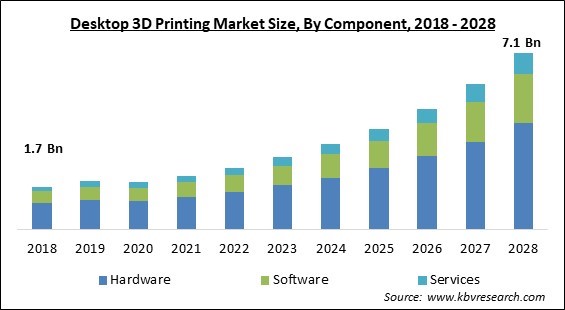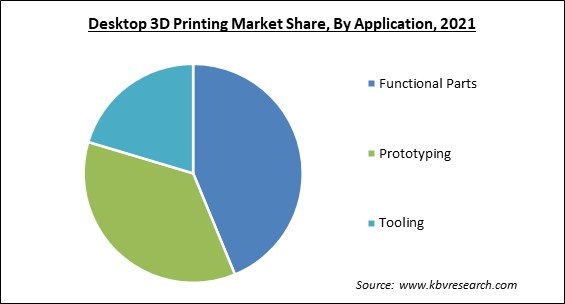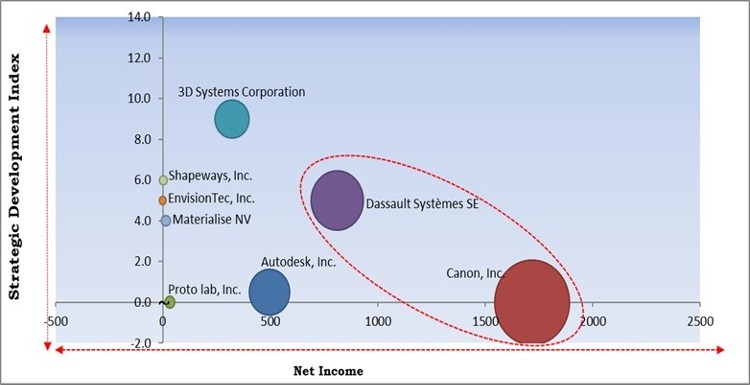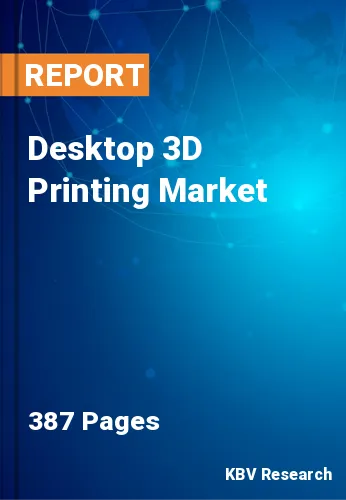The Global Desktop 3D Printing Market size is expected to reach $7.1 billion by 2028, rising at a market growth of 19.2% CAGR during the forecast period.
3D printing is a technology that generates objects commonly referred to as additive manufacturing. It provides a wide range of potential for the creation, design, and performance of unique architectural shapes, construction systems, and materials. It is a cutting-edge, quick, and agile approach to product development and production.
A desktop 3D printer is a compact 3D printer that can construct items from scratch. Owing to the fact that they can be used on a standard desk, they are referred to as desktop 3D printers. They don't need a wide area. Desktop 3D printers, in contrast, are tiny & portable. They are perfect for tiny workstations due to their compact size. A manufacturing business might not have the option of deploying a large 3D printer if it operates out of a tiny plant. Fortunately, there is a space-saving alternative provided by desktop 3D printers. They are a desirable option for small workstations since they may fit on the surface of a desk.

The demand for desktop 3D printers is being driven by the growing use of additive manufacturing and the rising need for advanced manufacturing & rapid prototyping across many industries. Rapid prototyping has become more popular, which has helped businesses create effective systems & products. During the forecast period, these aspects are anticipated to work together to drive market growth.
The growing adoption of 3D printing technology across several verticals is also greatly influenced by the ease of production and various advantages it offers. Manufacturers can benefit from 3D printing through prototyping, structural design of structures and finished goods, modeling, and accelerated time to market. It has dramatically decreased production costs, enabling businesses to sell premium goods at competitive pricing.
Many industries have been badly impacted by the outbreak of COVID-19. Both the production process and the availability of raw materials have been halted as a result. These elements all had an impact on the market expansion for personal 3D printers. Education, entertainment, & photography—the three industries that use 3D printers—are not operational during this pandemic condition. As a result, the demand for 3D printers has significantly decreased over the past financial quarter, and similar trends are predicted for the upcoming quarter as well.
One of the most significant benefits of 3D printing technology is that it requires low labor costs. Labor costs have a significant impact on determining the budgetary allocation for building a framework. When it comes to conventional production, labor costs are very high and skilled machine operators are required. But with 3D printers, all that is required, is for the operator to press a button; the rest of the operation is carried out automatically by the printer. Additionally, mass & small-scale manufacturing are equivalent when producing goods utilizing 3D printing.

The deployment of this technology over traditional manufacturing techniques is how quickly 3D printers can manufacture models. The 3D printing is quicker & simpler than traditional manufacturing processes. The rapid incorporation of ideas & designs using 3D printing occurs from the blueprint stage to the finished product. A CAD model can be utilized to extract complex patterns that can then be printed, and the process only takes a few hours.
There are additional 3D printing technologies available in the market. A manufacturing company may need to spend more money on a larger commercial 3D printer if it wishes to use alternative technology. As compared to bigger commercial 3D printers, some desktop printers have worse accuracy. This is one of the certain drawbacks of using a desktop 3D printer. A desktop 3D printer might not work well for applications that call for precise forms and sizes. There are still a lot of really precise desktop 3D printers available in the market. Commercial 3D printers, however, are frequently the most precise.
On the basis of component, the desktop 3D printing market is fragmented into hardware, software (Design Software, Inspection Software, Printer Software & Scanning Software) and services. The hardware segment led the desktop 3D printing market by generating maximum revenue in 2021. The segment's expansion has been propelled by sophisticated production techniques & rapid prototyping. The growth is being fueled by a number of factors, such as increased consumer electronic device penetration, growing industrialization & urbanization, the development of civil infrastructure, and reduced labor costs.
Based on technology, the desktop 3D printing market is segmented into stereolithography, fuse deposition modeling, selective laser sintering, digital light processing, laminated object manufacturing and others. The stereolithography segment covered a substantial revenue share in the desktop 3D printing market in 2021. Users of the stereolithography technique can produce idea models, intricately detailed complex parts, & quick cosmetic prototypes. This is one of the oldest techniques for creating 3D printed objects. Incorporating the stereolithography apparatus (SLA), which turns liquid plastic into solid objects, is the process.
By application, the desktop 3D printing market is classified into prototyping, tooling & functional parts. In 2021, the prototyping segment witnessed a significant revenue share in the desktop 3D printing market. Prototyping has been widely adopted across a number of business industries. Prototyping is used in the design & development of intricate systems, parts, and components in the aerospace and defense, automotive, industries. Manufacturing companies can create trustworthy finished items because of the incredibly exact outcomes of prototyping. All these factors would support the market growth.
On the basis of vertical, the desktop 3D printing market is categorized into education, fashion & jewellery, objects, dental/healthcare, food and others. In 2021, the fashion and jewelry segment garnered a substantial share of the desktop 3D printing market. The market growth has been fueled by the growing adoption of 3D printing in the production of miniatures, apparel, imitation jewelry, clothing & art, and craft. For the purpose of creating 3D-printed jewelry, the ideas of investment casting & lost wax casting are combined with the capabilities of a digital design and production process.
Based on material, the desktop 3D printing market is divided into plastic, metal and ceramic. The metal segment procured a significant revenue share in the desktop 3D printing market in 2021. As the demand for direct manufacture of complex end-use parts increases, metals for 3D printing is becoming more & more common. Metals make traditional manufacturing processes' tooling simpler, resulting in reduced costs & shorter lead times. The creative flexibility of 3D printing and the mechanical properties of the metal are combined in metal 3D printing.
| Report Attribute | Details |
|---|---|
| Market size value in 2021 | USD 2.1 Billion |
| Market size forecast in 2028 | USD 7.1 Billion |
| Base Year | 2021 |
| Historical Period | 2018 to 2020 |
| Forecast Period | 2022 to 2028 |
| Revenue Growth Rate | CAGR of 19.2% from 2022 to 2028 |
| Number of Pages | 387 |
| Number of Tables | 684 |
| Report coverage | Market Trends, Revenue Estimation and Forecast, Segmentation Analysis, Regional and Country Breakdown, Competitive Landscape, Companies Strategic Developments, Company Profiling |
| Segments covered | Component, Material, Technology, Application, Vertical, Region |
| Country scope | US, Canada, Mexico, Germany, UK, France, Russia, Spain, Italy, China, Japan, India, South Korea, Singapore, Malaysia, Brazil, Argentina, UAE, Saudi Arabia, South Africa, Nigeria |
| Growth Drivers |
|
| Restraints |
|
Region-wise, the desktop 3D printing market is analyzed across North America, Europe, Asia Pacific and LAMEA. The North America led the desktop 3D printing market with the maximum revenue share in 2021. Factors that are anticipated to drive the market in the region include the existence of big companies in the region and customers' ability to spend more than in this region. The high defense budget in the United States combined with the use of 3D-printed metal components in government & private aerospace industries is anticipated to drive market growth.
Free Valuable Insights: Global Desktop 3D Printing Market size to reach USD 7.1 Billion by 2028

The major strategies followed by the market participants are Product Launches. Based on the Analysis presented in the Cardinal matrix; Dassault Systèmes SE and Canon, Inc. are the forerunners in the Desktop 3D Printing Market. Companies such as 3D Systems Corporation, Shapeways, Inc. and EnvisionTec, Inc. are some of the key innovators in Desktop 3D Printing Market.
The market research report covers the analysis of key stake holders of the market. Key companies profiled in the report include Dassault Systèmes SE, 3D Systems Corporation, Autodesk, Inc., Canon, Inc., Materialise NV, EnvisionTec, Inc. (Desktop Metal, Inc.), Voxeljet AG, Stratasys, Ltd., Proto lab, Inc., and Shapeways, Inc.
By Application
By Vertical
By Technology
By Component
By Material
By Geography
The global Desktop 3D Printing Market size is expected to reach $7.1 billion by 2028.
More Budget Friendly are driving the market in coming years, however, Availability Of Better Alternatives In The Market restraints the growth of the market.
Dassault Systèmes SE, 3D Systems Corporation, Autodesk, Inc., Canon, Inc., Materialise NV, EnvisionTec, Inc. (Desktop Metal, Inc.), Voxeljet AG, Stratasys, Ltd., Proto lab, Inc., and Shapeways, Inc.
The Functional Parts segment acquired maximum revenue share in the Global Desktop 3D Printing Market by Application in 2021 thereby, achieving a market value of $3.1 billion by 2028.
The Plastic segment is leading the Global Desktop 3D Printing Market by Material in 2021 thereby, achieving a market value of $3.9 billion by 2028.
The North America market dominated the Global Desktop 3D Printing Market by Region in 2021, and would continue to be a dominant market till 2028; thereby, achieving a market value of $2.4 billion by 2028.
Our team of dedicated experts can provide you with attractive expansion opportunities for your business.

